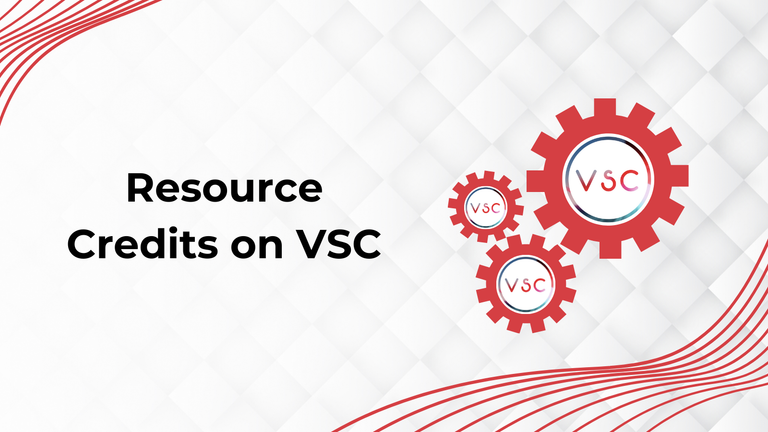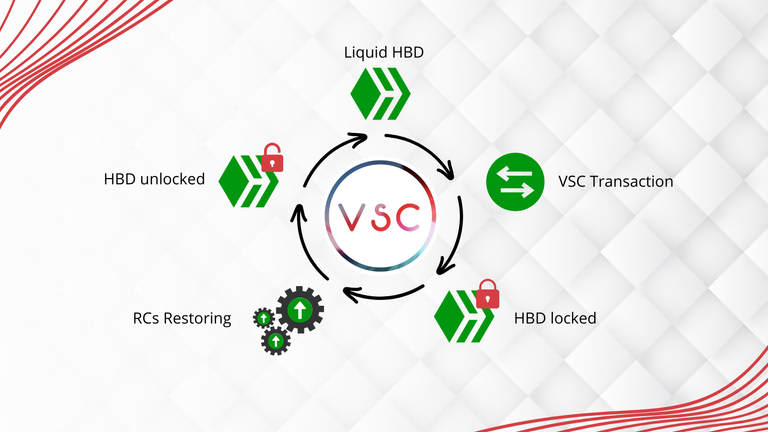
Introduction
One question that will always be asked when getting started with a new blockchain is, “are there transaction fees?”. In most cases, the answer is “yes”, and it really comes down to how expensive those fees are at any given time. The majority of users in the cryptocurrency space, whether it be an Ethereum user or Bitcoin user, have paid some kind of transaction fee to have their transaction included in the blockchain. This is standard for most blockchains, especially Proof of Work chains.
The Hive blockchain, along with VSC, are much different in this aspect because they do not require transaction fees. In place of transaction fees, Hive transactions each have a different Resource Credits cost to perform the action. You might be thinking to yourself, “Well, that’s just a different kind of transaction fee”. While that is a totally fair assessment at the surface level, it’s quite different when you dive into the details of how it all works.
Resource Credits on Hive
Instead of having variable transaction fees, Hive uses a fee-less system that leverages rechargeable Resource Credits (RCs). RCs are assigned to your account based on your Hive Power, which is staked HIVE. Each different type of transaction on Hive consumes a different amount of RCs, depending on the complexity of the transaction and the state of the network’s activity.
RCs recharge at a rate of 20% per 24-hour period, so accounts will only be able to use the amount of RC relative to that account’s Hive Power. It typically takes about 5 days for an account to fully recharge if all of the RCs have been used. Once all RCs are depleted, the user can stake more HIVE as Hive Power to get more or wait for their RCs to recharge. RCs are a way for the Hive blockchain to maintain its scalability and speed by ensuring that accounts only allocated bandwidth proportionate to their Hive Power.
This RC system helps ease the friction of new users interacting with the blockchain by making transaction fees virtually free. One of the biggest hurdles to overcome when starting out on a new blockchain is figuring out how to pay for transactions as they will typically cost something. Compared to Ethereum, for example, all users will need to purchase additional ETH that will be spent every time they make a transaction. These fees are can get quite expensive, and at the same time it can represent a financial risk by making them decide between holding the assets or using them for fees. Hive's Hive Power and RC system makes a lot more sense, and ends up not costing the user anywhere near as much.
What about Resource Credits on VSC?
Now that you know how RCs work on Hive, lets start with the key difference between Hive and VSC in this aspect: you won’t need to stake your assets until you make a transaction.
Normally on Hive, you would need to stake HIVE in order to get more RCs for your daily activity. With VSC, you just need to make sure to have enough HBD before you make a transaction. This is liquid HBD, held on the VSC network. On VSC, X amount of RCs are assigned to each HBD. This removes the need to stake any assets before making transactions and also removes the need to make an additional transaction to stake an assets, leading to an even easier experience getting started. When you make a transaction, Y amount of HBD is automatically locked for a set period, proportionate to the amount of RCs needed.

RCs on VSC are non-liquid assets that are set based on your liquid HBD and as you use them, your HBD will be locked Y period of time. For example, X amount of RCs is assigned to 1 HBD, so, if you perform a transaction that consumes Z amount of RCs, Z/X = amount of HBD will get locked for Y period of time. While time passes and you don't perform any transactions , your HBD will slowly unlock in your wallet. The key here is that as soon as a user receives HBD, they can already start making transactions on VSC.
As HBD is transferred between wallets on VSC, the RCs associated with that HBD move with it. This means that new accounts are ready to start transacting the moment they have an HBD balance. This is a drastically different experience than what is currently available on most blockchains. We strongly believe that onboarding should be incredibly simple, and having an RC system designed this way is a great start.
It is important to note that HBD locked for RCs is not the same as sHBD (staked HBD) on VSC. If a user wants to stake their HBD, they will receive liquid sHBD which can be transferred. We've carefully designed our transaction system around HBD, and it exists in a few different forms on our network. You can read more about the key differences in our previous post.
Fixing RC delegations
Currently on Hive, there is a huge issue with the delegation of RCs. That issue is the problem of over or under delegation of RCs. The majority of Hive accounts even with RC delegations either don’t use their RCs, wasting those of the provider, or uses too much and runs into roadblocks. Users with large amounts of Hive Power are constantly accruing RCs that they will never use effectively, creating a negative impact on the new user onboarding experience. Keeping in mind that RCs are limited and a way to distribute network bandwidth, this is a big problem and a very inefficient system.
Looking at this from the perspective of a dApp, like a game, that covers the cost to onboard a new user, it increases the RC costs significantly due to this inefficiency. New users essentially get more expensive in terms of RCs the more Hive usage grows and RCs are allocated to more users. This results in dApps having to buy more HIVE to stake as Hive Power over time just to continue onboarding users, even if those users do not actually use any the RCs. The way Hive's RC system is designed results in a long-term problem with account creation costs and is highly inefficient. There needs to be a better way to manage RC distribution.
Taking RC delegations a step forward
When designing the RC system for VSC, we took this issue into account. That is one of the reasons why RCs are available immediately without staking. Now, we are taking RC delegation a step further by enabling RCs to be delegated instantly on a per transaction basis, as opposed to managing long standing delegations. This is a substantial improvement to the current model of managing a delegation which may or may not be used, in favor of a much more dynamic approach that properly addresses dApp needs.
As long as a DApp has enough liquid HBD in their wallet, they can instantly delegate RCs to a new user to get an account and make all the transactions the user needs. This design removes the friction from signing up and starting to make transactions, turning it into a seamless and more efficient process. DApps also have the ability to include spam prevention measures to ensure RCs can't be taken advantage of, and this could be done down to the transaction type level. It also opens the door to monetization models or subscription models in exchange for on-demand RCs. Our goal is to make this model highly scalable and efficient.
Another thing to note is that because VSC unlocks smart contracts for Hive, RCs can be used for more different types of interactions. Your users will be able to do more complex operations such as NFT minting or more computationally intensive tasks, while RCs remain cost-efficient. This is vastly different than the simple interactions that currently exist on Hive. such as commenting or posting blogs.
In Conclusion
Traditionally, blockchains have a pretty simple fee structure for transactions that puts the cost on the user. Hive paved the way for us to design a bandwidth management system for VSC that would be radically different. We have taken Hive's Resource Credits protocol to another level, and made it more flexible. With scalability and flexibility at the forefront of our vision for VSC, we have made the RCs system much more efficient in the long-term. Our network will be able to adapt and scale to the needs of just about any application, without the limitations of an inefficient network bandwidth management system. This is just another way that VSC is going to propel Hive into the future with hardcore innovation and development.
Don’t hesitate to leave us a comment with your thoughts or questions about it. Be sure to check out some of our latest articles below to stay up-to-date on all things VSC and crypto.
Congratulations @vsc.network! You have completed the following achievement on the Hive blockchain And have been rewarded with New badge(s)
Your next payout target is 5000 HP.
The unit is Hive Power equivalent because post and comment rewards can be split into HP and HBD
You can view your badges on your board and compare yourself to others in the Ranking
If you no longer want to receive notifications, reply to this comment with the word
STOP